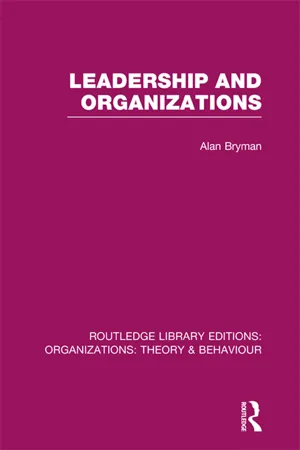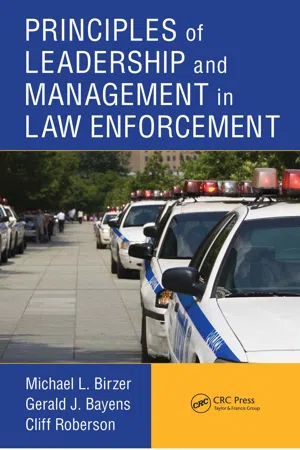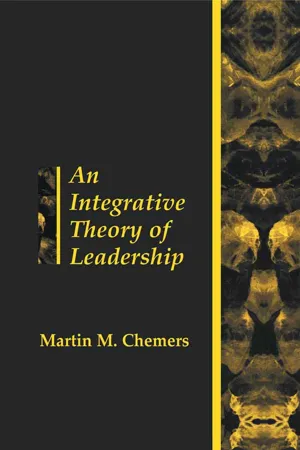Fiedler Contingency Model
The Fiedler Contingency Model is a leadership theory that suggests the effectiveness of a leader is contingent on the situation. It proposes that the match between a leader's style and the favorableness of the situation determines leadership effectiveness. The model categorizes leaders as either task-oriented or relationship-oriented, and recommends matching the leader's style to the situation for optimal performance.
8 Key excerpts on "Fiedler Contingency Model"
- eBook - ePub
Leadership of Higher Education Assessment
A Guide to Theory for Practitioners
- Matthew B. Fuller(Author)
- 2019(Publication Date)
- Routledge(Publisher)
...The leader’s style will be influenced by a number of factors, such as their relationship with faculty and staff, availability or resources, or pressures to complete a given task. Therefore, the leader’s chosen leadership style is said to be contingent upon these factors. Situational Leadership is similar to Contingency Theory and should not be thought of as a competing construct. Situational Theories call upon a leader’s skills and natural theories to respond to situations leaders and organizations face. However, a leader’s chosen leadership style is not dictated or contingent upon organizational factors, leaving considerable flexibility theorizing about leadership patterns that would emerge. To draw a broad division, Contingency Theories hold that organizational contexts will dictate a leader’s style; Situational Theories offer leaders more flexibility in selecting leadership styles with at least some reference to organizational contexts. Let’s take a closer look at perhaps the most widely cited Contingency Theory, Fiedler’s Contingency Theory. FIEDLER’S CONTINGENCY THEORY Contingency Theory emerged from trait theories in the latter half of the 20th century. Psychologist Fred Fiedler developed a theory that not only proffers traits of effective leaders but also takes into account contexts in which organizations find themselves. Fiedler’s Contingency Theory (1978) positions effective leadership as dependent not only on the leader’s style but on his/her control over contexts and whether the leader prefers to work with people or tasks to achieve control over these contexts. According to Fiedler, a leader’s style depends upon the favorability of the leadership situation. Three factors determine how favorable a situation is to a leader: (a) leader-member relations, (b) task structure, and (c) position power. Leader-member relations addresses the extent to which leaders are trusted and liked by team members...
- eBook - ePub
- Vibrant Publishers, Dr. Carrie Picardi(Authors)
- 2021(Publication Date)
- Vibrant Publishers(Publisher)
...that need to be performed. The characteristics of the leader’s followers. (The Peter F. Drucker Foundation, 1996) Additionally, different leader behaviors and strategies are necessary at various stages of group or organizational development. In the start-up phase, a situation may require focus in establishing a vision and mission, gaining exposure, and generating enthusiasm. Moving into the growth phase, a situation may call for developing a strategy, establishing core values and principles, planning short and long-term goals and objectives, and creating roles for members. As the group or organization progresses, there may be situations that emerge of varying degrees of change, re-assessment, crisis, and success. To that end, it is important for leaders to have the knowledge, skills, and tools to competently navigate a group through diverse situations and changing needs, sometimes well out of their own comfort zone. In the following sections, we will examine several foundational theories and models of situational and contingency-based leadership. Fiedler’s Contingency Theory The research of Fred Fiedler in the area of situational and contingency leadership is widely recognized and respected, conducted largely through working with an array of groups directed by a formal leader in a structured leadership role. Fiedler surmised that effective leadership is not solely the result of a leader’s attributes, nor is it exclusively based on the nature of the situation. Fiedler proposed that a leader’s effectiveness is contingent on both their attributes/leadership style and the level of control they have over the current situation. Moreover, the level of situational control is dependent on (1) leader-member relations; (2) task structure including clarity of goals, roles, tasks, and expectations; and (3) legitimate position power and scope of group authority (Fiedler, 1964). Fiedler and his colleagues developed an assessment tool called the Least Preferred Co-worker (LPC) scale...
- eBook - ePub
Studying Leadership
Traditional and Critical Approaches
- Doris Schedlitzki, Gareth Edwards(Authors)
- 2017(Publication Date)
- SAGE Publications Ltd(Publisher)
...On a more practical note, we may question to what extent it is possible for leaders to be as flexible and accommodating in their leadership style as is suggested by this model. What is the organisational culture and what are the organisational pressures on the leader? To what extent may this pose barriers to his/her ability to be either more supportive or directive towards their followers? Critical Thinking Box 3.1 Models such as the situational leadership theory assume that there is a ‘right’ way of leading in a specific situation and that this ‘right’ way can be determined, learned and changed. They have therefore been very popular in leadership development practice. Given these strong, positive assumptions, how might these models get used or abused in organisations and particularly in the development of leaders? LPC Contingency Theory In contrast to the situational leadership theory, Fiedler’s (1964, 1967; Fiedler and Garcia, 1987) contingency theory assumes that leaders cannot change their behaviour. It therefore aims to match leaders based on their preferred leadership style to specific situations and contexts. Leader effectiveness is hence said to be contingent on the right match of a leader’s style to an appropriate situation. The LPC contingency theory is based on extensive empirical work conducted in predominantly military organisations, where Fiedler and colleagues studied and assessed leaders’ styles in different contexts. They used the patterns that started to emerge to formulate generalisations about best fit between specific styles and specific situations/contexts. The theory based on these generalisations should therefore enable organisations to pick the right leader with the right style for a specific situation. Critical Thinking Box 3.2 Many of the early-20th-century leadership theories are based on research conducted within a military context...
- eBook - ePub
- John Antonakis, David V. Day(Authors)
- 2017(Publication Date)
- SAGE Publications, Inc(Publisher)
...Its placement in our scheme of the trait and behavioral contingency approaches to leadership is not as transparent; however, it seems that the focus is on both leader traits (e.g., Offermann, Kennedy, & Wirtz, 1994) and leader behaviors (Lord, Foti, & DeVader, 1984). As we explain later, leadership categorization demonstrates how expectations about leaders vary due to their role or the situation. In the following subsections, we briefly describe each of these models and present a matrix to compare the models and theories based on their approach to assessing the leader, the situation, and leadership outcomes (see Table 6.1). Leader Trait Contingency Models Two contingency models exist that show the situational factors that intervene between the leader’s characteristics and various outcomes: contingency model of leadership effectiveness and cognitive resource theory. In both these models, the characteristics of the leader relate to individual- and group-level outcomes, but the extent of this relationship depends upon the situation. In this section, we will review each model and discuss the contextual factors in detail. Contingency Model of Leadership Effectiveness. Fiedler (1964) was the first to formulate a trait contingency model of leadership effectiveness, which became known as the contingency model of leadership effectiveness. In this model, Fiedler (1978) predicted leader or group success from the interaction of the leader’s orientation (i.e., task or relationship) with the leader’s situational control. A leader’s orientation is an internal state and is not directly related to observed behaviors (Ayman, 2002). This orientation is fairly stable and is similar to the way in which personality is conceptualized. To measure a leader’s orientation toward the work setting, the model uses the Least Preferred Coworker (LPC) scale (e.g., Ayman & Romano, 1998)...
- Alan Bryman, Alan Bryman(Authors)
- 2013(Publication Date)
- Routledge(Publisher)
...For example, in a re-analysis of the Chemers and Skrzypek (1972) West Point study, Shiflett (1973, p. 434) found that leader-member relations had a very strong independent effect on performance. It was by far the most important contributing factor to variation in performance, much more so than any of the leadership style plus situational context combinations which the model suggests should be more important. It may be that the positive findings of validation studies which compare Leader Match trained groups with control groups can in part be explained by such effects. The Leader Match idea is likely to remain controversial as long as the Contingency Model from which it is derived suffers from conflicting views about its validity. The main contribution of the Contingency Model has been to provide an approach to the study of leadership in which situational factors are not merely residual phenomena but central ingredients of an account of leadership effectiveness. While the Fiedler approach has attracted a good deal of controversy, the essence of the model has been enormously influential. The suggestion that a leader's effectiveness is contingent upon the situation has found much more favour than the specific model with which Fiedler has been associated. The contingency approaches to the study of leadership which will be discussed below can be seen as alternative formulations to Fiedler's Contingency Model. House's path-goal theory of leadership While Fiedler's approach to the study of leadership has often been denigrated for lacking a theoretical framework (e.g. Ashour, 1973), the same cannot be said of House's influential path-goal approach which in large part is an application of the ideas of the ‘expectancy theory’ of work motivation to the domain of leadership. While a number of varieties of this theory exist, the fundamental tenets have been retained in most of the formulations...
- Michael L. Birzer, Gerald J. Bayens, Cliff Roberson(Authors)
- 2012(Publication Date)
- Routledge(Publisher)
...What might work in one organization or employee group might not work in a different organization with its own set of issues and employee concerns. This methodology acknowledges that no one best way exists to manage in a given situation, and those situational variables, from both the internal and external environments, impact leadership practices. Exhibit 4.3 Hersey-Blanchard model of maturity level and leadership style. In 1976, Fred Fiedler published A Theory of Leadership Effectiveness, which introduced his famous contingency theory, classifying leaders according to the extent to which they are relationship-or task-oriented. Relationship-oriented leadership is predicated on the desire to achieve personal acceptance. Task-oriented leadership is generated by effective task accomplishment. Fiedler then classifies situations in terms of the task structure for subordinates and the power position of the leader. Task structure is the extent to which a task is defined and understood as compared to an ambiguous and poorly outlined task. For example, police organizations rely on policy and procedure manuals to define tasks that are to be performed by police officers. In Chapter 7, we will discuss the use of policy and procedures by police agencies. The power position of the leader refers to the degree to which the status confers authority and the level at which others accept and comply with directions. The question then becomes: Can we change our leadership styles to suit the situation? It is difficult, but studies have shown that leadership styles can indeed be learned. The best example of this is the path-goal theory proposed by Robert House, which includes the interaction of leadership behaviors with situation characteristics in determining the leaders’ effectiveness...
- eBook - ePub
- Martin Chemers(Author)
- 2014(Publication Date)
- Psychology Press(Publisher)
...Chapter 4 More Contingency Theories The presentation of Fiedler’s Contingency model in the 1960s created considerable controversy, but it also provided leadership researchers with a new, more productive approach to the problem. A second generation of contingency theories followed the contingency model and reflected a variety of perspectives. The two most prominent of the second generation contingency theories were House’s (1971) path-goal theory of supervision and Vroom and Yetton’s (1973) normative decision theory. This chapter deals extensively with these two models, as well as with some related theories that did not have as great an impact on the research literature, but nonetheless offer valuable insights. THE PATH-GOAL THEORY OF LEADERSHIP One of the weaknesses of Fiedler’s contingency model that was discussed in the last chapter was its failure to describe or directly analyze the processes by which the leader’s motivational orientation affects group processes and outcomes. One obvious path for leadership effects to follow is through the psychological states of the followers, the people who must aid the leader in accomplishing the mission. Following this logic, leadership can be construed in terms of its effects on the motivation and satisfaction of followers. Many motivational theories of the time were influenced by instrumentality notions (Vroom, 1964) that conceptualized motivation in terms of an actor’s perception of the likelihood that certain behaviors would result in (i.e., be instrumental for) gaining desired outcomes. Georgopoulos, Mahoney, and Jones (1957) offered a “path-goal” instrumentality model that argued that motivation to engage in a behavior was a function of the product of the person’s perception of the probability that the behavior would lead to a goal and the perceived importance of the goal. A natural question concerns what sorts of factors influence an actor’s perceptions of the path-goal probabilities...
- eBook - ePub
Dynamics of Leadership in Public Service
Theory and Practice
- Montgomery Van Wart(Author)
- 2014(Publication Date)
- Routledge(Publisher)
...With these theoretical “building blocks” in place, the following chapters examine specific theories in more detail. Contingency Factors As should be evident from these discussions, an immense number of factors affect the leader’s preferred modes of action (exhibited as styles) and the degree of effectiveness of those actions. What does the leader think the overall goals should be? What are the task skills of the followers? What is subordinate effort like? How good is the organization of the work and how does this align with performance strategies? What types of constraints do leaders have to incorporate, including their own abilities such as traits, skills, and behavioral competencies? The social scientist studying leadership wants to know not only which contingencies are important but also exactly how important each factor is. In other words, how much explanatory power does each factor provide in different classes of situations? For example, a social scientist may test the often-held assumption that emergencies (one type of task contingency) require a directive mode of leadership (one type of leadership style). Ideally, the researcher can examine situations in which identical emergencies are handled with and without a directive style. Further, the researcher would compare different types of emergencies using experimental and control groups. It is easier to understand the effects of contingencies on leadership styles when only one or a few contingencies dominate...







